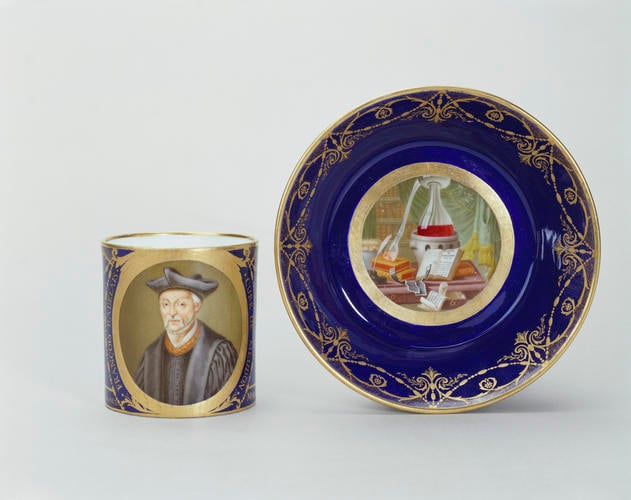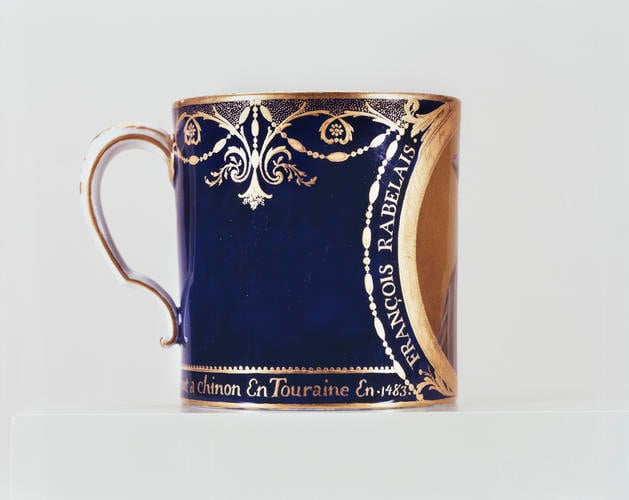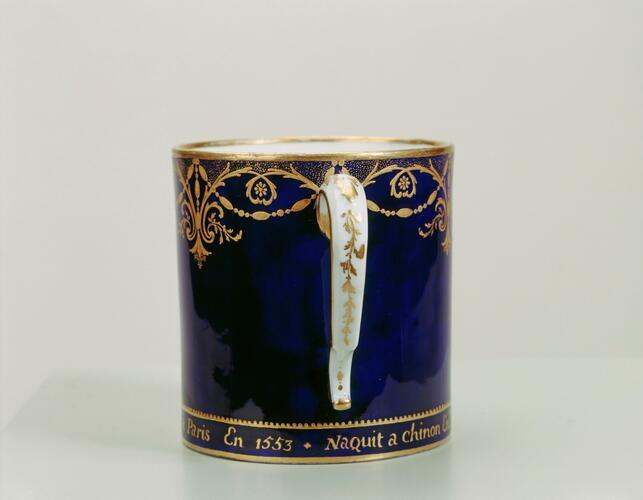Gobelet litron c. 1793
Soft-paste porcelain, beau bleu ground and gilded decoration | Cup 7.6 x 9.6 x 7.2, saucer 3.9 x 14.6 (whole object) | RCIN 58185
-
First produced in 1752, the gobelet litron was a popular model at Vincennes and Sèvres throughout the eighteenth century. The cylindrical cup received its name because of its resemblance to the litron, an old wooden cubic measure of slightly larger dimensions, used to quantify salt, grain, flour and peas
The gobelet litron was among the earliest ‘useful wares’ produced at the manufactory. Although the vast majority of gobelets litrons were made to be used, some were intended to serve as eye-catching knick-knacks for display on chimneypieces and occasional tables. They were perfect gifts and towards the end of each year the production of expensive gobelets litrons sharply increased in order to provide sufficient stock for the Kings’ end-of- year sales staged in Versailles. While matching sets of gobelets litrons were produced to be incorporated into déjeuners and cabarets, others were sold singly, and yet others were grouped together to form sets of contrasting decoration.
The cup is painted in polychrome with a half-length portrait of François Rabelais, the writer, doctor and humanist. He is painted against a greenish fawn background and is dressed in grey with brown-coloured fur to his doublet. The inscription in gold round the portrait reads: ‘françois rabelais curé de meudon’; and round the foot of the cup: ‘NaQuit a chinon En Touraine En. 1483. Mourut a Paris En 1553’. The underside of the cup is inscribed in gold: ‘Inhumé Dans le Cimtiere De St Paul, il fut Médecin. Poïte jurisconsulte. Grammairien Théologien. Philosophe Et Astronome’.
The saucer is decorated with scholarly articles, a still life disposed on a desk in a book-lined room; olive-coloured drapery with gold fringing partly conceals bookshelves, on a table are an inkwell and feather pen, books, pamphlets and a retort with pink-coloured liquid in the smaller bottle-shaped container and red liquid in the larger vessel sitting in a pierced terracotta bowl. The open book is inscribed: ‘histoire de gargantua cha vii’; and the document protruding from the open drawer reads ‘belais curé meudon m a Luchow bourdon a pucelage’.
Pithou le jeune, who almost certainly painted the portrait of Rabelais, has faithfully copied an engraving by Nicolas Habert (c.1650-1715), while drawing also on the accompanying text for the inscriptions. The inscriptions and items disposed on the saucer allude to Rabelais’ interests and activities: ‘belais’, his role as reader, secretary, medical adviser, librarian and friend of Jean Cardinal du Bellay; ‘curé meudon’, the post he held from January 1550 to January 1552; the retorts, which recall his degree as doctor of medicine; Gargantua, the novel he published in 1554. The specific reference to Chapter VII would have recalled Gargantua’s early years and his rapidly developing taste for drink: ‘au seul son des pinthes & flaccons, il entroit en ecstase, comme s’il goustoit les joyes de Paradis … il s’esgayoit, il tressallloit [sic]’ and, in a typically uninhibited manner, ‘se bersoit en dodelinant de la teste, monochordisant des doigtz & barytonnant du cul’.
There would appear to be at least three versions of this cup. On 8 January 1791 Louis XVI purchased at the end-of-year sales in Versailles a cup valued at 240 livres, described as ‘1 Tasse Rabelais’. The cup had been sold to an unnamed buyer on 1 January 1791 only to be returned that same day to the manufactory in part exchange for a biscuit figure. This cup can probably be identified in the kiln records. Painted by Nicolas-Pierre Pithou le jeune and gilded by Le Guay, it was fired in the kiln on 28 March 1791. A curious transaction is recorded in the painters’ ledger under Pithou le jeune’s name in 1793. In May of that year he received in kind a ‘Gobelet de Rabelais’ valued at 96 livres in lieu of payment for two bands (‘cerces’) of a pair of vases. Bearing in mind its stated value, it seems unlikely to have been the same cup as that acquired by Louis XVI.
The cup in the Royal Collection can probably be identified in the Sèvres Archives. Fired in the kiln for painted decoration on 5 August 1793 was ‘1 Gobelet et s 1e g Beau bleu Rabelais [painter] Pithou [gilder] Le Guay’. Paradoxically It must have been one of the first pieces produced at the manufactory bearing the name Sèvres and the initials RF in place of the royal interlaced LLs. The change was made at the behest of the comte Dominique-Joseph Garat, Minister of Justice from 19 March to 19 August 1793. In a letter to Antoine Régnier, Director of the manufactory, dated ‘17 Juillet 1793 L’an 2 de la Republique’, he wrote that, in order to avoid offending the sensibilities of ‘L’homme devenu Libre … Je crois … nécessaire de substituer dorénavant à la marque ordinaire le mot Sevres, accompagné des lettres initiales de Republique français, R.F. … Vous voudrèz bien en conséquence faire dans le plus court délai tout ce qui sera nécessaire pour opérer ce changement dans la marque des porcelaines’.
Text adapted from French Porcelain: In the Collection of Her Majesty The Queen, London, 2009Provenance
Purchased for seven guineas by Nicholas Morel for George IV at the Phillips’ sale, 22–29 March 1797, Lot 652 (‘A superb Seve Cabinet Cup and Saucer, Mazarine blue and gold ground, enriched by a striking portrait of Rabelais’). Recorded in 1826 in the Confectionary, Carlton House: ‘No. 215. A Cup and Saucer in blue and gold painted with a Portrait of Rabelais’.
-
Creator(s)
(porcelain manufacturer)(nationality)Acquirer(s)
-
Medium and techniques
Soft-paste porcelain, beau bleu ground and gilded decoration
Measurements
Cup 7.6 x 9.6 x 7.2, saucer 3.9 x 14.6 (whole object)
Place of Production
Sèvres [France]












